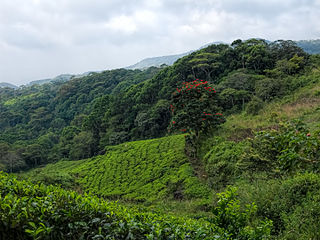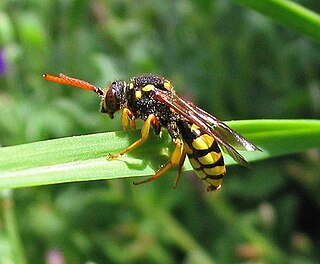Related Research Articles

Sinharaja Forest Reserve is a forest reserve and a biodiversity hotspot in Sri Lanka. It is of international significance and has been designated a Biosphere Reserve and World Heritage Site by UNESCO.

With over 850 species, the genus Nomada is one of the largest genera in the family Apidae, and the largest genus of kleptoparasitic "cuckoo bees." Kleptoparasitic bees are so named because they enter the nests of a host and lay eggs there, stealing resources that the host has already collected. The name "Nomada" is derived from the Greek word nomas (νομάς), meaning "roaming" or "wandering."
Wildlife of Sri Lanka includes its flora and fauna and their natural habitats. Sri Lanka has one of the highest rates of biological endemism in the world.
Lasioglossum carinifrons, also known as the Lasioglossum (Evylaeus) carinifrons, is a species of bee in the genus Lasioglossum, of the family Halictidae.
Sphecodes decorus is a species of bee in the genus Sphecodes, of the family Halictidae. S. decorus has been documented in India and Sri Lanka.
Coelioxys capitata is a species of leaf-cutting bee in the genus Coelioxys, of the family Megachilidae. It is found in India, and recordings from Sri Lanka are uncertain, but considered true.
Coelioxys confusa is a species of leaf-cutting bee in the genus Coelioxys, of the family Megachilidae. It is found in Himachal Pradesh, India, and while recordings from Sri Lanka are uncertain, they are considered to be true.
Coelioxys fenestrata is a species of leaf-cutting bee in the genus Coelioxys, of the family Megachilidae. It is found in India, and recordings from Sri Lanka is uncertain.
Coelioxys fuscipennis is a species of leaf-cutting bee in the genus Coelioxys, of the family Megachilidae. It is found in India, and recordings from Sri Lanka is uncertain.
Heriades parvula is a species of leaf-cutting bee in the genus Heriades, of the family Megachilidae. It is also spelled Heriades parvulus.
Nomada adusta, is a species of bee belonging to the family Apidae.
Nomada bicellularis, is a species of bee, belonging to the family Apidae subfamily Nomadinae. It is endemic to Sri Lanka.
Nomada ceylonica, is a species of bee belonging to the family Apidae subfamily Nomadinae. It is found from Sri Lanka and south India.
Nomada wickwari, is a species of bee belonging to the family Apidae subfamily Nomadinae. It is endemic to Sri Lanka.
Nomada lusca, is a species of bee belonging to the family Apidae subfamily Nomadinae. It is found in Sri Lanka, India and Philippines.
Nomada priscilla, is a species of bee belonging to the family Apidae subfamily Nomadinae. It is found in Sri Lanka, India and Philippines.
Tetraloniella taprobanicola, also known as Tetraloniella (Tetraloniella) taprobanicola, is a species of bee belonging to the family Apidae subfamily Apinae. It is found endemic to Sri Lanka.
References
- ↑ "An Annotated Catalogue of the Bee Species of the Indian REgion-Nomada". Beesind.com. Retrieved 2015-11-07.